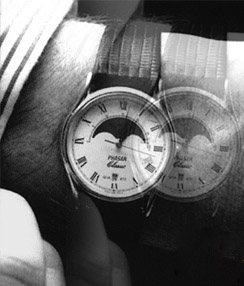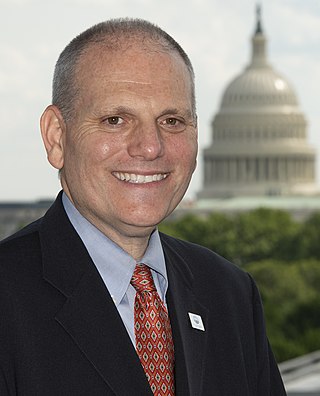
Optic neuritis describes any condition that causes inflammation of the optic nerve; it may be associated with demyelinating diseases, or infectious or inflammatory processes.

Ophthalmology is a clinical and surgical specialty within medicine that deals with the diagnosis and treatment of eye disorders. A former term is oculism.

Septo-optic dysplasia (SOD), known also as de Morsier syndrome, is a rare congenital malformation syndrome that features a combination of the underdevelopment of the optic nerve, pituitary gland dysfunction, and absence of the septum pellucidum . Two or more of these features need to be present for a clinical diagnosis—only 30% of patients have all three. French-Swiss doctor Georges de Morsier first recognized the relation of a rudimentary or absent septum pellucidum with hypoplasia of the optic nerves and chiasm in 1956.

Argyll Robertson pupils are bilateral small pupils that reduce in size on a near object, but do not constrict when exposed to bright light. They are a highly specific sign of neurosyphilis; however, Argyll Robertson pupils may also be a sign of diabetic neuropathy. In general, pupils that accommodate but do not react are said to show light-near dissociation (i.e., it is the absence of a miotic reaction to light, both direct and consensual, with the preservation of a miotic reaction to near stimulus.

Diplopia is the simultaneous perception of two images of a single object that may be displaced horizontally or vertically in relation to each other. Also called double vision, it is a loss of visual focus under regular conditions, and is often voluntary. However, when occurring involuntarily, it results from impaired function of the extraocular muscles, where both eyes are still functional, but they cannot turn to target the desired object. Problems with these muscles may be due to mechanical problems, disorders of the neuromuscular junction, disorders of the cranial nerves that innervate the muscles, and occasionally disorders involving the supranuclear oculomotor pathways or ingestion of toxins.
Neuro-ophthalmology is an academically-oriented subspecialty that merges the fields of neurology and ophthalmology, often dealing with complex systemic diseases that have manifestations in the visual system. Neuro-ophthalmologists initially complete a residency in either neurology or ophthalmology, then do a fellowship in the complementary field. Since diagnostic studies can be normal in patients with significant neuro-ophthalmic disease, a detailed medical history and physical exam is essential, and neuro-ophthalmologists often spend a significant amount of time with their patients.
Oscillopsia is a visual disturbance in which objects in the visual field appear to oscillate. The severity of the effect may range from a mild blurring to rapid and periodic jumping. Oscillopsia is an incapacitating condition experienced by many patients with neurological disorders. It may be the result of ocular instability occurring after the oculomotor system is affected, no longer holding images steady on the retina. A change in the magnitude of the vestibulo-ocular reflex due to vestibular disease can also lead to oscillopsia during rapid head movements. Oscillopsia may also be caused by involuntary eye movements such as nystagmus, or impaired coordination in the visual cortex and is one of the symptoms of superior canal dehiscence syndrome. Those affected may experience dizziness and nausea. Oscillopsia can also be used as a quantitative test to document aminoglycoside toxicity. Permanent oscillopsia can arise from an impairment of the ocular system that serves to maintain ocular stability. Paroxysmal oscillopsia can be due to an abnormal hyperactivity in the peripheral ocular or vestibular system.
Blepharospasm is a neurological disorder characterized by intermittent, involuntary spasms and contractions of the orbicularis oculi (eyelid) muscles around both eyes. These result in abnormal twitching or blinking, and in the extreme, sustained eyelid closure resulting in functional blindness.

Apraclonidine (INN), also known under the brand name Iopidine, is a sympathomimetic used in glaucoma therapy. It is an α2 adrenergic receptor agonist and a weak α1 adrenergic receptor agonist.
Ocular ischemic syndrome is the constellation of ocular signs and symptoms secondary to severe, chronic arterial hypoperfusion to the eye. Amaurosis fugax is a form of acute vision loss caused by reduced blood flow to the eye; it may be a warning sign of an impending stroke, as both stroke and retinal artery occlusion can be caused by thromboembolism due to atherosclerosis elsewhere in the body. Consequently, those with transient blurring of vision are advised to urgently seek medical attention for a thorough evaluation of the carotid artery. Anterior segment ischemic syndrome is a similar ischemic condition of anterior segment usually seen in post-surgical cases. Retinal artery occlusion leads to rapid death of retinal cells, thereby resulting in severe loss of vision.

Susac's syndrome is a very rare form of microangiopathy characterized by encephalopathy, branch retinal artery occlusions and hearing loss. The cause is unknown but it is theorized that antibodies are produced against endothelial cells in tiny arteries which leads to damage and the symptoms related to the illness. Despite this being an extremely rare disease, there are four registries collecting data on the illness; two are the United States, one in Germany, and one in Portugal.
Looming is a term found in the study of perception, as it relates directly to psychology. Looming occurs when an object begins moving closer to the eye. As the resulting image becomes increasingly larger on the perceiver's retina, i.e., when an object looms, there is an automatic physiological response to perceive the object as an approaching object or surface, instead of one that is stationary or receding. Evidence indicates that looming perception is not limited to the visual modality, but can occur due to auditory or even tactile stimuli.
Annapoorna Kini is an American cardiologist. She is Professor of Cardiology and Interventional Director of Structural Heart Program at Mount Sinai School of Medicine in New York City.
Neuro-Ophthalmology is an English language, peer-reviewed medical journal that covers diagnostic methods in neuro-ophthalmology such as visual fields, CT scanning and electrophysiology, the visual system such as the retina, oculomotor system, pupil, neuro-ophthalmic aspects of the orbit, and related fields such as migraine and ocular manifestations of neurological diseases.

William C. Daroff is the CEO of the Conference of Presidents of Major American Jewish Organizations.
Bascom Palmer Eye Institute is the University of Miami School of Medicine's ophthalmic care, research, and education center. The institute is based in the Health District of Miami, Florida, and has been ranked consistently as the best eye hospital and vision research center in the nation.

Orbital lymphoma is a common type of non-Hodgkin lymphoma that occurs near or on the eye. Common symptoms include decreased vision and uveitis. Orbital lymphoma can be diagnosed via a biopsy of the eye and is usually treated with radiotherapy or in combination with chemotherapy.
Joseph R. Berger is an American internist and neurologist who is known for his research interests in progressive multifocal leukoencephalopathy (PML), the neurological complications of HIV/AIDS, multiple sclerosis, and other inflammatory disorders of the brain. Particularly, he contributed research on why PML occurs more frequently in AIDS than in other immunosuppressive conditions.
Bienfang's test is a clinical test used in the diagnosis of ocular myasthenia gravis. It is used in conjunction with other examination techniques such as Cogan's lid twitch test or enhancement of blepharoptosis from prolonged upward gaze. It is a simple, quick, and non-invasive test for ocular myasthenia gravis that can be performed not only by ophthalmologists or neurologists, but also by other physicians evaluating patients with ptosis, diplopia, or other symptoms of myasthenia gravis.
Frank Burton Walsh was a Canadian-American ophthalmologist known for his work in neuro-ophthalmology. For most of his career, Walsh worked as a neuro-ophthalmologist at the Wilmer Eye Institute of Johns Hopkins Hospital. Walsh is best known for his textbook Clinical Neuro-Ophthalmology, which contains a compilation of Walsh's case reports and the conclusions he drew from them. Originally published in 1947, the textbook has many updated versions and is still a premier text in the field of neuro-ophthalmology. Walsh is considered by many to be the father of neuro-ophthalmology due to his contributions to the field.








